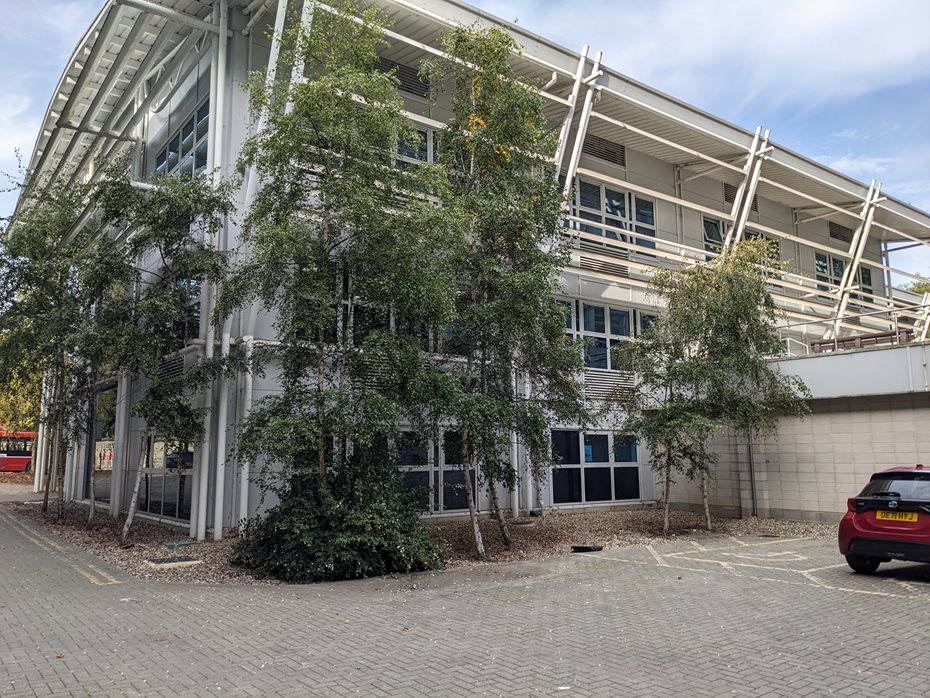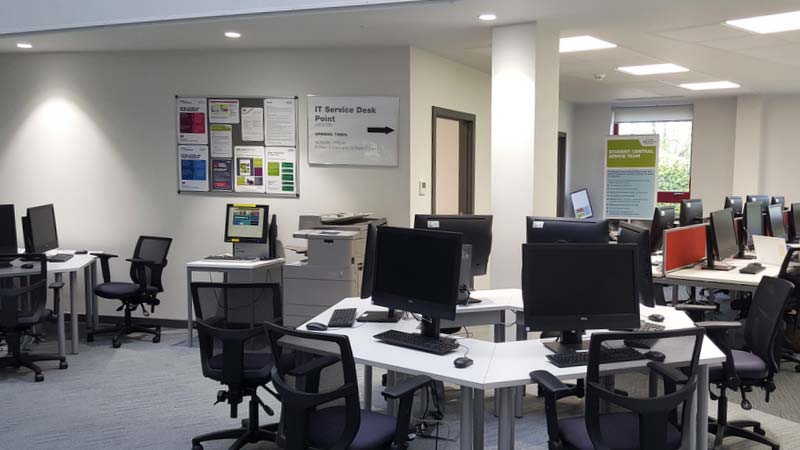News Assistive Technology Suite - Marston G.27a : Opening 8 Sep 2025
Assistive Technology support
Using assistive or academic technology (AT) can help with more effective study/working. It can benefit all students and you may already be using it - 30% of students nationally surveyed in 2022 said they use captions or transcripts. It can be particularly helpful for students where English is not their first language, who have experienced an injury, have health issues, are disabled, or have a specific learning difficulty (SpLD).
All Brookes students can book an appointment to discuss and explore potential tools to help with studies and remote working on their own devices, such as:
- extra features in the programs you use all the time (MS Office, Google apps)
- making the most of your computer with features in your browser (eg Chrome) and operating system (eg Windows)
- recommendations for study-related apps for mobile phones and tablets (many of which are free).
Learning Labs
The Learning Labs AT and Inclusivity hub includes Labs (tutorials) on understanding and getting the most out of assistive technology, accessibility tools and remote learning software.
Learn how to use Brookes’ assistive technology (AT) programs (from Apps Anywhere or loans), at anytime and anywhere using this portal.
For advice on how to log in to the platform, follow the Learning Labs login guide.
- ClaroRead - Text-to-Speech, allows you to listen to your documents, the built in converter means you can use almost any file.
- WritingHelper - provides steps to help you structure your written work.
- MS Office 365 - Immersive reader makes documents easier to read by allowing you to improve your focus on the text.
- MS Office 365 - Editor on Home tab: gives feedback on clarity, formality and conciseness.
- HelperBird - AT tools for your browser (Chrome, Firefox, Edge).
- AT app Tools - Call Scotland downloads with links including Chromebooks and iPads.
- Windows user - Try MyStudyBar - collection of free download AT and links to training videos.
- For ideas look at Techability - see the poster 'Making technology work for you'.
- My Computer My Way - AbilityNet.
- Changing web page settings.
Individual sessions are available via Google Meet to look at software and equipment to aid remote learning and online study (30 or 60 minutes).
- Tuesday - Thursday from 9:00am
Face-to-face support, in the AT Suite, Buckley Building, Headington Campus (45 minutes) - on request
- Tuesday from 9:00am
- Wednesday from 9:00am (Weeks 1- 11, Semester 1, 2025)
| Time | Event | Location |
|---|---|---|
| 12:30-1:45pm | AT Advice -Think Space Study Advice - Forum Wednesdays (1 Oct 2025, week 2, Online only) | Think Space, John Henry Brookes Building, G.02 (Forum level) |
| 2:00-3:00pm | AT Advice - ATS Buckley Wednesdays (1 Oct 2025, week 2, Online only) | Assistive Technology Suite, Buckley Building, G.26 |
“A quiet place to think and work. ”
Assistive Technology Suites user
Alternative formats are used to help make documents accessible and enable you to use your Assistive Technology (AT) to read them. You can use Moodle, Sensus Access or ClaroRead to create accessible files such as accessible PDFs, audio files, electronic braille and ebooks.
The Assistive Technology Suites (ATS) house learning technology for exclusive independent use by disabled students. Contact us on ATS@brookes.ac.uk for more information and to request access.
Some of the technology available in the ATS includes:
- mind mapping software that helps you plan essays and revise for exams
- text to speech software and headphones so that you can listen to electronic text read aloud
- screen reading software which reads out the whole screen
- screen magnification software which expands a part of the screen so it can be seen more easily
- magnifiers which display enlarged images of books
- ergonomic equipment such as ergonomic chairs, keyboards, mice and adjustable desks
- speech to text software that writes down what you say.
If you would like to use the room, please contact your disability adviser.
Online
- Appointments are available Tuesday - Thursday from 9.00am on request (via Google Meetings, Google Hangouts, etc). Click the link to join the meeting (Google calendar appointment or email invite).
- Information about useful software built into your operating system or common software (MS Office and Google Apps) is available.
- Brookes Networked PCs offer ClaroRead (text to speech - reading aloud) in Apps Anywhere.
Headington Campus
The Buckley Building (ground floor) G.23, Headington Campus
During semester:
- Use the enquiry form or email to arrange an online session.
- Note: Outside semester, email to agree a time for an online session via Google Meetings.
Marston Road Campus
The AT room MR G.27a in the Gym block, is in a quiet space at the far end of the corridor (on the left hand side) - there is a door code and booking system.
Availability: Campus opening times, Monday - Friday 7.30am - 7.00pm
Swindon Campus
JOF.G.09b, The Library, Joel Joffe Building, Swindon Campus
During semester:
- Use the booking form or email AT support to arrange an online session.
- Note: Outside semester, email to agree a time for an online session via Google Meetings.
What is available on loan from the ATS?
- Microphones
- Magnifier on USB
- Audio notetaking software
“If I had tried out the various accessible software and technology options in the ATS, before my needs assessment, I could have benefited even more.”
Assistive Technology Suites user



Learning and AT
AT can be used in different ways at all stages of your learning:
- Input: help you to take in new information and content.
- Processing: assimilate, understand what you have been learning.
- Output: demonstrate your learning and understanding through your assignments or exams.
Example functions of AT
- Text to speech (TTS) helps text impairment by reading texts or web page content out loud, students often use it to listen to their written work for proof reading (you can also convert text to a downloadable recording to listen to away from the screen).
- Screen readers read the whole screen, including tabs, titles, and links to allow easier navigation of a screen you can’t see.
- Magnification enlarges the whole screen or specific sections.
- Speech (to text) allows users to dictate text without focusing on spelling, but can also be used to command the computer’s actions without using mouse or keyboard.
- Videos with captions (YouTube/Panopto/Zoom has basic auto-caption capability built-in).
- Mind-mapping offers a visual representation for holistic, non-linear thinking used for notes, planning and structuring:
- capturing ideas that come quickly or in no specific order
- grouping ideas to see themes, topics or processes
- structuring responses and bringing together evidence and examples
- rehearsing recall of ideas for revision.
AT resources
AT physical resources
- Coloured paper, highlighters and overlays etc can help with visual perception of content.
AT hardware
- Large screen, reading pen, hearing aids, wireless microphones for teaching staff, printer/scanner, high contrast or large font keyboards and specialist mouse formats.
AT software
- Software can read text aloud to you, allow text creation by dictation, magnify and read screen details, or let you plan in a visual way, mind-maps. It can allow you to navigate without a mouse by hotkey combinations or alternatively without a keyboard by voice.
- Useful tools are found at various levels of your IT, built-in to the operating system (especially Mac) but also in applications like MS Office and Google apps, or extensions to your browser as well as specialist software. There are also apps for your mobile device to record, magnify, scan, help with time management or read aloud.
- Depending on where it is found it may be free in existing software you are using. Specialist software may have a one off cost to purchase or an annual / course length subscription.
ClaroRead (££/free)
Text to speech: ClaroRead desktop version is available on Brookes pooled room computers and through AppsAnywhere; ClaroRead Chrome browser extension offers limited text to speech on web pages. Learn how to use it in Learning Labs
Inspiration (£)
Inspiration is mindmapping software that allows you to export your map and notes to MS Word, available on Brookes pooled room computers through Apps Anywhere. Contact AT Support team about access to a loan copy.
Dragon (££££)
Dragon is speech recognition software that allows you to dictate content (and learns your voice profile) but also allows you to command / navigate your computer without using a mouse/keyboard. Available on selected PCs in the AT suites.
NVDA - free
NVDA is screen reader software for Windows PCs which allows you to hear everything that is on the screen, headings, lists, buttons alt text for images and text. It works in browsers (Chrome, Firefox) and Office programs (Word & Excel).
Speechify - (£)
Speechify is a chrome extension, for text to speech - an AI reader, with a premium subscription version. It works on Chrome, Android and iOS platforms.
